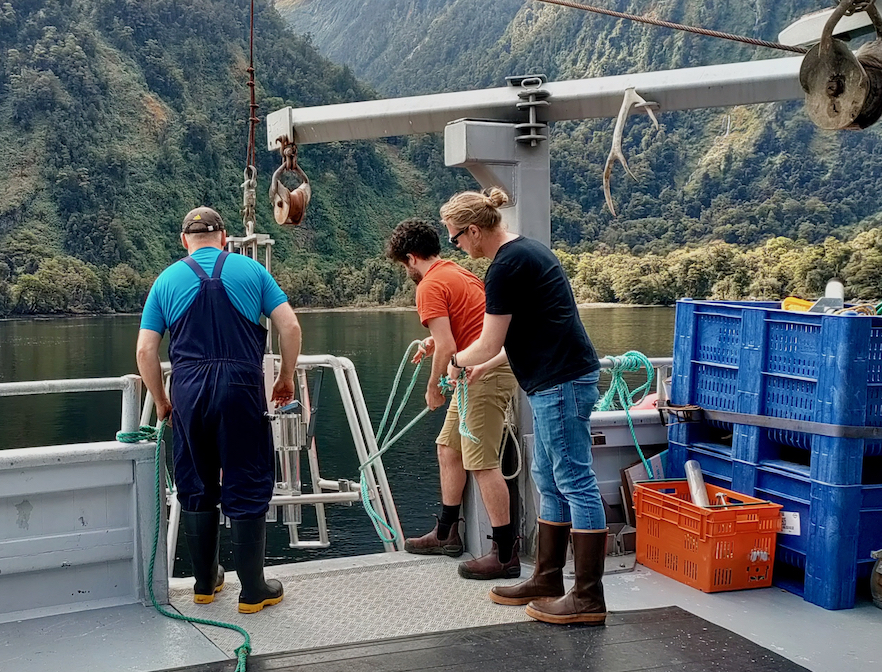Our research is investigating the natural ability of Fiordland's marine sediments to collect and store carbon that is fixed from the atmosphere by the surrounding rainforest and marine ecosystem. We will assess the vulnerability of this significant carbon sink to human impacts including forest and water management and changing climate and ocean conditions.
More about our research approach
Our research findings will support the government to improve reporting of blue carbon (marine sequestration) in the New Zealand Greenhouse Gas Inventory. We will assess options to protect and possibly enhance the storage potential of this valuable natural asset.
Initial estimates are that the amount of carbon sequestered in the deepest parts of the fiords is equivalent to 10 to 20% of New Zealand's greenhouse gas emissions.
Contact us:
Email chris.moy@otago.ac.nz

Analyses of sediments from the deep basins in Fiordland, New Zealand allows us to reconstruct the past environment to understand how vulnerable this blue carbon environment is to changing climate and oceanic conditions.
Ō mātou tākata | Our people
This 5-year programme is funded by MBIE-Endeavour and is co-hosted by the University of Otago and GNS Science. The team includes mana whenua, paleoscientists, sedimentologists, atmospheric scientists and modellers, oceanographers, geochemists, economists and marine managers from a wide range of institutions in Aotearoa New Zealand and abroad.
Programme Leaders
Chris Moy, Paleoclimatology, Sedimentology, Geochemistry, University of Otago
Gary Wilson, Paleoclimatology, Paleoceanography, GNS Science
Research team
-
Gael Arnaud: Physical Oceanography.
MetOcean Solutions Ltd -
Helge Arz: Paleoceanography, Paleoclimatology.
Leibniz Institute for Baltic Sea Research Warnemünde -
William Austin: Palaeoceanography, Marine Geology.
University of St Andrews -
Troy Baisden: Hydrology, Isotope Geochemistry, Carbon Sequestration, Policy.
University of Waikato and Motu -
Catherine Beltran: Paleoceanography, Sedimentology, Organic Geochemistry.
University of Otago -
Thomas Bianchi. Biogeochemistry.
University of Florida -
Stewart Bull: Mātauranga Māori, Marine and Terrestrial Governance and Management.
Ngāi Tahu ki Murihiku, Fiordland Marine Guardians and Southland Conservation Board. -
Robert Dunbar: Climate Dynamics, Oceanography, Marine Ecology, and Biogeochemistry, Environmental Policy.
Stanford University -
Tania Gerrard: Māori and Stakeholder Relations, Policy Analysis.
GNS Science -
Greer Gilmer: Sedimentology, Geochemistry.
GNS Science -
Andrew Gorman: Geophysics, Marine Seismology.
University of Otago -
Liz Keller: Data Science, Modelling.
GNS Science -
Frank Lamy. Paleoceanography, Paleoclimatology.
Alfred Wegener Institute Helmholtz Centre for Polar and Marine Research -
Rebecca McLeod: Marine ecology, Marine management.
University of Otago and Fiordland Marine Guardians -
Christina Riesselman: Paleoceanography, Paleoclimatology.
University of Otago -
Caroline Saunders: Applied Economics.
Lincoln University -
Candida Savage: Marine Ecology, Paleoecology, Nutrient Cycles.
University of Otago -
Robert Smith: Physical Oceanography.
University of Otago -
Claudine Stirling: Isotope and Trace Element Geochemistry.
University of Otago -
Jocelyn Turnbull: Greenhouse Gas Science and Policy.
GNS Science and National Oceanic and Atmospheric Administration (NOAA) Global Monitoring Division -
Marcus Vandergoes: Paleoecology.
GNS Science
University of Otago postgraduate students
- Jack Beagley, PhD candidate: Oceanography, Marine Seismology.
- Jorgee Robb, MSc candidate: Geochemistry.
- Luke Whibley, MSc candidate: Carbon Cycling.
Kaupapa rakahau | Research approach
The research approach involves collecting and analysing sediment cores from the seafloor to develop an understanding of how carbon input and sequestration to the fiords has varied over the past approximately 15,000 years. The variations will be related to changing climate and ocean conditions over that time. Models that incorporate current atmospheric, oceanic and forest productivity data will then enable future scenarios to be forecast. An economic model will be developed in parallel that will allow the costs and benefits of various management approaches to be interrogated.
Fiords capability as natural carbon sinks
Fiords are carbon cycle 'hotspots' that bury the largest amount of organic carbon per unit area in the world. It is estimated that, though they occupy less than 0.1% of Earth's surface, annual fiord carbon burial accounts for 11% of the total annual global marine sequestration (blue carbon).
The South Island's fiords may be one of New Zealand's largest natural carbon sinks, and some of the highest carbon burial rates in the world have been observed here. Forest carbon is efficiently sequestered in fiords because plants and soils rapidly enter the marine environment rather than oxidising on the landscape. The combination of steep country, dense native forest, high precipitation (6-8 meters per year) and frequent landslides drive an efficient system that continuously fixes carbon, transports it to sub-oxic deep marine basins and sequesters it long term.
A recent estimate of Aotearoa New Zealand's carbon budget derived from atmospheric measurements and modelling found a previously unidentified carbon sink in Fiordland that is large enough to offset 10 to 20% of the country's greenhouse gas emissions.
Given the valuable ecosystem service provided by natural climate regulation, it is imperative that we understand the drivers of carbon sequestration, the size of the carbon sink in Fiordland, and the vulnerability of this natural asset to future changes in climate, ocean circulation and management of the forests, water ways and marine environment.
Manawhenua partnerships
Our partnership with Ngāi Tahu ki Murihiku will result in a comprehensive research programme supporting Ngāi Tahu's Environmental Management Plan for climate change, freshwater and fjords. The research approach will facilitate knowledge uptake and implement mātauranga-a-iwi into policy and management directives. Our research strategy mirrors the view of Ngāi Tahu, looking to both the past and future to shape long-term mindset and actions.
Programme research objectives
The programme will:
- Provide the scientific basis to determine how future changes in fiord circulation, driven by changing climate and freshwater input will impact the carbon sink;
- Quantify the size of buried carbon stocks and calculate annual carbon burial to advocate for the inclusion of fiord systems in carbon accounting schemes in New Zealand and internationally;
- Determine the potential offsetting carbon cost of enhanced freshwater inputs to the fiords; and
- Support our partners to make successful environmental management decisions and recommendations to government that ensure protection of the carbon sink:
